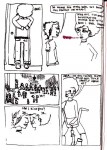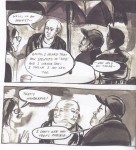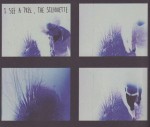I can’t help feeling cheated by the title of this anthology: Gay Genius1 is not as much gay as queer, lesbian, transgender—but only nominally gay. So, cheated, but in a good way, because this 144-page book presents the work of over a dozen artists I’d never heard of, apart from two of them, and I’m always very happy to discover “new” artists, whose contributions range from autobio to fiction and illustrations, from crude lines on papers to sophisticated paintings and collages, but who always seem to be very engaged in their pieces.
The general feel of the contributions is very underground, and to be honest, more underground than I’m used to reading, if only by being beyond the bounds of what is usually called “comics” in storytelling terms. But that also means that these stories can touch people who are not usually into comics, but who might be more receptive to the DIY feel of zines, and that is certainly a larger potential audience than comics readers like myself. Anyway, I’ll try to give you an idea of that feel with a few words on some of these contributions.
The first piece is by Matt Runkle, and if you’ve read my reviews of his comics, you already know that I think he’s a talented artist who’s ready to try and use various storytelling styles and address a wide range of themes. Here, in a story also included in Runkle’s Runx #2, Runkle pays homage to a deceased friend of his, Samantha Jane Dorsett. It’s not the only homage in this book, and another contribution, by Ellery Russian, tells of her meeting with Tanis Doe, a disabled lesbian who apparently possessed an impressive personality, drawn by Russian with solid storytelling and expressive art.
The intersection of multiple issues, such as queer/disabled, is a constant theme in Gay Genius. Another contribution illustrates this with a powerful tale of growing up black and queer: LeRoi Newbold‘s Becozwehaf2 tells in the first person the story of Tess, a young girl who navigates elementary school while wondering whether having “fake sex” with another girl will give her aids. This story worked for me thanks to the way the childlike naiveté of the narrator was used to convey serious themes. It was also a good example of how art (and especially lettering) that looks, let’s say, home-made can tell a moving story.
Another contribution I found moving was Clio Reese Sady‘s The Get-Together, which recounts the 1986 meeting of female-to-male transsexuals. They frankly discuss issues such as sexual orientation (some identify as gay, some don’t) and sex in general, and the artist uses soft washes that give a kind of dream-like quality to a story that’s very much about real-life questions. She also manages to not make us feel like voyeurs, always a risk when real people talk about such intimate matters.
The editor of this anthology, Annie Murphy (there’s a good interview of Murphy here), also contributes what might be the one of the few pieces that wouldn’t feel out-of-place at indie publishers such as Drawn & Quarterly (by which I don’t mean that it’s better than the other stories, simply more professional-looking). Truth: Stranger than fiction is the story of Babe Bean, an American woman who lived and dressed (mainly) as a man from the end of the XIXth century up to his death in 1936. Using text from articles found in newspapers of the period, Murphy breathes new life into that era with detailed art and warm colors, examining the attitudes of plain people and authorities when confronted with what was a major taboo breaker at the time. The pages included in this book are only the first part of Murphy’s story, and I hope she’ll find a publisher for the completed project.
Sarah Sass Biscarra-Dilley‘s Masahai is a complete departure from Murphy’s story: motifs from American Indian’s tradition build a short portrait of a Mohave man. The art is vibrant, and has less in common with comics than with contemporary art. I’d very much like to see more from this artist who, like other contributors, is at a thematic crossroads, this time between queer and Indian issues.
I could write about each contribution, but I hope I’ve already given you a taste of the variety of this anthology. I could mention that Edie Fake, whose Gaylord Phoenix I’ve just reviewed, also has a few illustrative pieces in this book, and that there’s an artist named Jackie Davis who uses negative, blue-tinted photographs to tell the short but fascinating story of a walk at night.
Comics, illustrations, paintings, photographs…The diversity of styles and techniques used by the artists in this book is a proof, if need be, of the vitality of the queer scene. Most of the stories show a holistic point-of-view (as opposed to a one-issue-at-a-time POV) regarding the issues they address, and that demonstrates the willingness of all those artists to wrestle with important issues in ways that are both deeply personal and intelligently political, in the best meaning of that word.
Notes:
- This book is available from Sparkplug Comicbooks, its publisher. ↩





 Bluesky feed
Bluesky feed